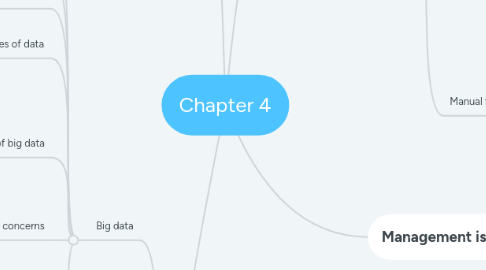
1. Datawarehouses
1.1. characteristics
1.2. data marts
1.3. data warehousing
1.3.1. 4 types
1.4. architecture
1.5. 5 steps of datawarehousing
1.5.1. 1. Internal and external Data
1.5.2. 2. Extract and transformation
1.5.3. 3. Data warehouse data
1.5.4. 4. Data analysis
1.5.5. 5. Client
1.6. ETL!!!!!
1.6.1. Extraction
1.6.2. Transformation
1.6.3. Lad
2. Analytics
2.1. Big data
2.1.1. Structured data
2.1.2. Unstructured data
2.1.3. semi-structured data
2.1.4. sources of data
2.1.4.1. sensors
2.1.4.2. the internet of things (IOT)
2.1.5. four V's of big data
2.1.5.1. volume
2.1.5.2. velocity
2.1.5.3. variety
2.1.5.4. veracity
2.1.6. concerns
2.1.6.1. where do they come from
2.1.7. techniques of data mining
2.1.7.1. types of data mining
2.1.7.1.1. text mining
2.1.7.1.2. speech mining
2.1.7.1.3. Web mining
2.1.7.2. Identifying sequences
2.1.7.3. Classification
2.1.7.4. Clustering
2.1.7.5. Cube analysis
2.1.7.6. Identifying associations
2.1.7.7. machine learning
2.2. Types of analytics
2.2.1. Descriptive analytics
2.2.1.1. IMPORTANT FOR EXAM
2.2.2. Predictive analytics
2.2.3. Prescriptive analytics
2.3. different types
2.3.1. databases for big data (HADOOP)
2.3.2. Blockchain: a distributed database
2.3.3. database software
2.3.4. SQL databases
2.3.5. NoSQL database
2.3.6. In-memory databases
2.3.7. Columnar databases
2.3.8. Document-oriented databases
2.3.9. Key-value databases
2.3.10. object-orientated database
2.4. visual analystics
2.4.1. spreadsheets
2.4.2. dashboards
2.4.3. scorecards
3. Databases
3.1. Electronic filling systems
3.1.1. advantages
3.1.2. business-level advantages
3.1.2.1. muli-user access
3.1.2.2. distributed access
3.1.2.3. speed
3.1.2.4. data quality
3.1.2.5. security
3.1.2.6. space efficiency
3.2. types of databases
3.2.1. file processing databases
3.2.2. flat-file database
3.2.3. free-form database
3.2.3.1. hypertext database
3.3. database management system (DBMS)
3.3.1. main types of DMBS
3.3.1.1. rational databases
3.3.1.2. security systems of data bases
3.3.1.3. Reports
3.3.1.4. Query
3.3.1.4.1. selection query
3.3.1.4.2. update query
3.3.1.5. filter
3.3.2. characteristics
3.4. Manual filling systems
3.4.1. disadvantages
